#aws ecs fargate
Explore tagged Tumblr posts
Text
AWS APP Runner Tutorial for Amazon Cloud Developers
Full Video Link - https://youtube.com/shorts/_OgnzyiP8TI Hi, a new #video #tutorial on #apprunner #aws #amazon #awsapprunner is published on #codeonedigest #youtube channel. @java @awscloud @AWSCloudIndia @YouTube #youtube @codeonedigest #code
AWS App Runner is a fully managed container application service that lets you build, deploy, and run containerized applications without prior infrastructure or container experience. AWS App Runner also load balances the traffic with encryption, scales to meet your traffic needs, and allows to communicate with other AWS applications in a private VPC. You can use App Runner to build and run API…

View On WordPress
#amazon web services#amazon web services tutorial#app runner#app runner tutorial#app runner vs fargate#aws#aws app runner#aws app runner demo#aws app runner docker#aws app runner equivalent in azure#aws app runner example#aws app runner review#aws app runner spring boot#aws app runner tutorial#aws app runner youtube#aws cloud#aws cloud services#aws cloud tutorial#aws developer tools#aws ecs fargate#aws tutorial beginning#what is amazon web services
0 notes
Text
Deploying ColdFusion Microservices Using AWS Fargate and ECS
#Deploying ColdFusion Microservices Using AWS Fargate and ECS#Deploying ColdFusion Microservices Using AWS Fargate#Deploying ColdFusion Microservices Using AWS ECS
0 notes
Text
Kumologica Container Inside AWS ECS Fargate
http://securitytc.com/TFq3db
2 notes
·
View notes
Text
Why DevOps Automation Services Are Crucial for Scalable Cloud Deployments
In the ever-evolving world of cloud computing, speed and stability are the cornerstones of modern software delivery. As cloud-native technologies mature, enterprises are under pressure to release features faster while ensuring zero downtime. This is exactly where DevOps automation services shine.
DevOps isn’t just a buzzword anymore—it’s a strategic shift in how development and operations teams collaborate. The goal? Delivering better software, faster. With automation layered into every stage of the pipeline, businesses can now eliminate bottlenecks, reduce manual intervention, and scale confidently.
⚙️ What is DevOps Automation?
DevOps automation refers to automating the repetitive, time-consuming tasks involved in software development, testing, deployment, and infrastructure provisioning. It includes:
CI/CD pipelines (Continuous Integration & Deployment)
Infrastructure as Code (IaC)
Automated testing & validation
Real-time monitoring and rollbacks
By automating these, companies improve consistency, minimize human error, and significantly cut deployment cycles from weeks to hours.
🚧 Common DevOps Pain Points
Despite its potential, implementing DevOps automation internally can be overwhelming. Enterprises often face:
Fragmented toolchains across departments
Lack of skilled DevOps engineers
Misconfigured pipelines causing delays
Over-reliance on manual QA and deployments
That’s why partnering with providers like Grupdev’s DevOps Automation Services makes business sense. Grupdev brings in proven DevOps frameworks, AWS-native tooling, and security-first automation to ensure your cloud deployments are smooth and secure.
🏆 Case Study: Fast-Scaling SaaS Platform
A SaaS startup with rapid user growth struggled with unreliable releases and hotfixes that often broke production. Grupdev stepped in to audit and overhaul their development pipeline.
Here’s what was delivered:
Git-based CI/CD using AWS CodePipeline
Automated testing for every PR
Containerized deployment via ECS Fargate
Rollback and monitoring built-in
Results within 30 days:
4× faster release cycles
80% fewer production errors
Complete pipeline visibility and rollback safety
💡 Business Benefits of DevOps Automation
Accelerated Time-to-Market: Deploy features in days, not months.
Stable Releases: QA automation ensures fewer bugs in production.
Efficient Teams: Free engineers from repetitive tasks and reduce burnout.
Cost Optimization: Scale your cloud infra smartly with IaC templates and performance monitoring.
📌 Get Started with the Right Partner
DevOps isn’t just about tools—it’s about culture, speed, and execution. Grupdev helps enterprises unlock full DevOps potential with cloud-native tooling, secure automation, and structured delivery models.
If you’re aiming to reduce lead times, improve uptime, and create a more efficient cloud environment, check out Grupdev’s DevOps Automation Services today.
✅ Summary Takeaways
DevOps automation drives faster and more reliable cloud deployments
Key tools include CI/CD, IaC, automated QA, and rollback pipelines
Grupdev ensures end-to-end pipeline automation with AWS expertise
A must-have strategy for scaling SaaS, Fintech, and Enterprise apps in 2025

0 notes
Text
AWS Exam Sample Questions 2025?
To effectively prepare for the AWS Certified Solutions Architect – Associate (SAA-C03) exam in 2025, follow these steps:
Understand the Exam Objectives – Review the official AWS exam guide to understand key topics.
Study with Reliable Resources – Use AWS whitepapers, documentation, and online courses.
Practice with Clearcatnet – Utilize Clearcatnet's latest practice tests to assess your knowledge and improve weak areas.
Hands-on Experience – Gain practical experience by working on AWS services in a real or simulated environment.
Review and Revise – Revisit important concepts, practice time management, and take mock tests before the exam.
By following this structured approach, you can confidently prepare and increase your chances of passing the SAA-C03 exam on your first attempt.
Which service allows you to securely connect an on-premises network to AWS?
A) AWS Direct Connect B) Amazon Route 53 C) Amazon CloudFront D) AWS Snowball
A company wants to host a web application with high availability. Which solution should they use?
A) Deploy on a single EC2 instance with an Elastic IP B) Use an Auto Scaling group across multiple Availability Zones C) Store website files on Amazon S3 and use CloudFront D) Host the application on an Amazon RDS instance
What AWS service allows you to run containerized applications without managing servers?
A) AWS Lambda B) Amazon ECS with Fargate C) Amazon RDS D) AWS Glue
Which AWS storage service provides automatic replication across multiple Availability Zones?
A) Amazon EBS B) Amazon S3 C) Amazon EC2 instance store D) AWS Snowball
How can you restrict access to an S3 bucket to only a specific VPC?
A) Use an IAM role B) Enable AWS Shield C) Use an S3 bucket policy D) Use a VPC endpoint policy
A company is designing a high-performance computing (HPC) solution using Amazon EC2 instances. The workload requires low-latency, high-bandwidth communication between instances. Which EC2 feature should the company use?
A) Placement Groups with Cluster Strategy B) Auto Scaling Groups C) EC2 Spot Instances D) Elastic Load Balancing
A company needs to store logs from multiple applications running on AWS. The logs must be available for analysis for 30 days and then automatically deleted. Which AWS service should be used?
A) Amazon S3 with a lifecycle policy B) Amazon RDS C) Amazon EFS D) Amazon EC2 instance with attached EBS volume
A company wants to run a web application in a highly available architecture using Amazon EC2 instances. The company requires automatic failover and must distribute incoming traffic across multiple instances. Which AWS service should be used?
A) AWS Auto Scaling and Application Load Balancer B) Amazon S3 and Amazon CloudFront C) AWS Lambda and API Gateway D) Amazon RDS Multi-AZ
A company is migrating a database from an on-premises data center to AWS. The database must remain online with minimal downtime during migration. Which AWS service should be used?
A) AWS Database Migration Service (DMS) B) AWS Snowball C) AWS Backup D) AWS Glue
An application running on Amazon EC2 needs to access an Amazon S3 bucket securely. What is the best practice for granting access?
A) Attach an IAM role with S3 permissions to the EC2 instance B) Store AWS access keys on the EC2 instance C) Use a security group to grant access to the S3 bucket D) Create an IAM user and share credentials with the application
For Getting More Questions and PDF Download Visit 👉 WWW.CLEARCATNET.COM
#AWS#AWSCertified#AWSCertification#AWSCloud#AWSCommunity#SAAC03#AWSExam#AWSSolutionsArchitect#AWSSAA#AWSAssociate#CloudComputing#CloudCareer#ITCertification#TechLearning#CloudEngineer#StudyTips#ExamPrep#CareerGrowth#LearnAWS#AWSJobs
0 notes
Text
AWS Modernization: Ambitiously Rejuvenating the Cloud Journey with Innovation
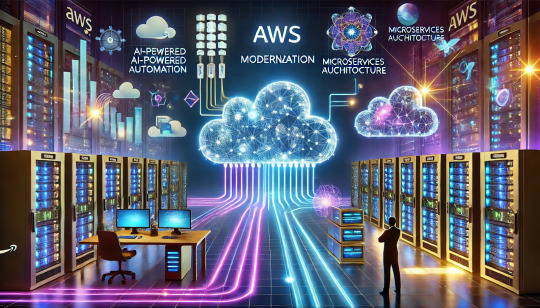
Firms are all rushing towards the cloud-basted solution due to massive demand for agility, cost-effectiveness, and innovation within this fast-paced digital epoch. AWS offers innovation solutions to modernize legacy architecture, optimize workloads and achieve operational excellence. This blog analyzes the features of some top AWS modernization services, showing how they can change the course of your cloud journey.
1. AWS Lambda
AWS Lambda is a serverless computing service that runs code without having to provision or manage servers. It scales automatically according to demand, so you can build scalable applications and reduce the infrastructure complexity.
2. Amazon ECS and EKS
Modernization of application deployment is now easier with Amazon ECS and EKS. This allows organizations to move towards containerization, has simplified application management, and assures scalability across environments.
3. AWS Fargate
AWS Fargate is a serverless compute engine for containers that eliminated the need for server management; therefore, the developers can focus on just developing apps. This not only optimizes resource use due to pay-as-you-go pricing and automatic scaling.
4. Amazon Aurora
Amazon Aurora is an extremely high-performing, resilient cloud-native relational database service that is compatible with open-source engines MySQL and PostgreSQL, making the tool ideal for any organization looking to migrate databases.
5. AWS Application Migration Service
The AWS Application Migration Service (AWS MGN) makes it easier to move applications from on-premises to AWS. It automates significant parts of the migration process and minimizes downtime.
6. AWS DevOps Tools
AWS has matured in terms of using numerous development tools, from AWS CodePipeline, AWS CodeBuild, and AWS CodeDeploy, that allow for continuous integration and continuous delivery (CI/CD), thus minimizing changes to development cycle times and effectiveness of deployment.
7. AWS Modernization Hub
The AWS Modernization Hub is a one-stop solution for the planning and execution of modernization projects. It provides insights, resources, and guidance toward fine-tuning modern architecture migration.
Utilization of AWS modernization solutions keeps organizations at the forefront, innovating ahead of time and optimizing business processes. With serverless computing, containerization, and automated migrations, AWS is the secret to your future-proof cloud. Using these very available solutions, organizations can create new avenues for growth and digital transform.
Conclusion
AWS modernization is a wholesale cleanup and not merely an upgrade in technologies for an enterprise to innovate, simplify, and expand at speed. The adoption of cloud-native architectures, serverless architectures, AI-driven automations, and DevOps practices envelop these capabilities with new levels of efficiency, security, and cost-competitiveness.
With this ambitious reimagination of the cloud experience, organizations are capable of taking the lead in the fast-paced competition of the digital world. Scaling modernization is assured with AWS tooling and frameworks, no matter if it is based on microservices, containerization, or machine learning integration.
Cloud innovation is endless. Organizations that respond nimbly and continuously update their AWS strategies will continue to prosper, taking advantage of the latest technologies in pursuing business growth and stability.
1 note
·
View note
Text
Deploying Containers on AWS ECS with Fargate
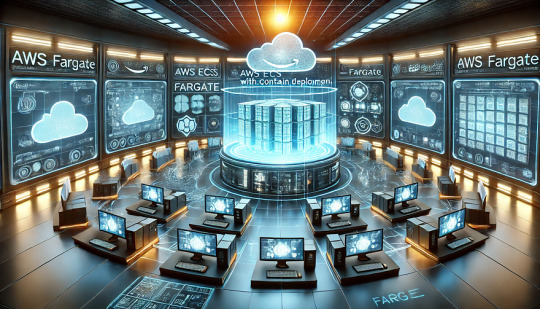
Introduction
Amazon Elastic Container Service (ECS) with AWS Fargate enables developers to deploy and manage containers without managing the underlying infrastructure. Fargate eliminates the need to provision or scale EC2 instances, providing a serverless approach to containerized applications.
This guide walks through deploying a containerized application on AWS ECS with Fargate using AWS CLI, Terraform, or the AWS Management Console.
1. Understanding AWS ECS and Fargate
✅ What is AWS ECS?
Amazon ECS (Elastic Container Service) is a fully managed container orchestration service that allows running Docker containers on AWS.
✅ What is AWS Fargate?
AWS Fargate is a serverless compute engine for ECS that removes the need to manage EC2 instances, providing:
Automatic scaling
Per-second billing
Enhanced security (isolation at the task level)
Reduced operational overhead
✅ Why Choose ECS with Fargate?
✔ No need to manage EC2 instances ✔ Pay only for the resources your containers consume ✔ Simplified networking and security ✔ Seamless integration with AWS services (CloudWatch, IAM, ALB)
2. Prerequisites
Before deploying, ensure you have:
AWS Account with permissions for ECS, Fargate, IAM, and VPC
AWS CLI installed and configured
Docker installed to build container images
An existing ECR (Elastic Container Registry) repository
3. Steps to Deploy Containers on AWS ECS with Fargate
Step 1: Create a Dockerized Application
First, create a simple Dockerfile for a Node.js or Python application.
Example: Node.js DockerfiledockerfileFROM node:16-alpine WORKDIR /app COPY package.json . RUN npm install COPY . . CMD ["node", "server.js"] EXPOSE 3000
Build and push the image to AWS ECR:shaws ecr create-repository --repository-name my-app docker build -t my-app . docker tag my-app:latest <AWS_ACCOUNT_ID>.dkr.ecr.<REGION>.amazonaws.com/my-app:latest aws ecr get-login-password --region <REGION> | docker login --username AWS --password-stdin <AWS_ACCOUNT_ID>.dkr.ecr.<REGION>.amazonaws.com docker push <AWS_ACCOUNT_ID>.dkr.ecr.<REGION>.amazonaws.com/my-app:latest
Step 2: Create an ECS Cluster
Use the AWS CLI to create a cluster:shaws ecs create-cluster --cluster-name my-cluster
Or use Terraform:hclresource "aws_ecs_cluster" "my_cluster" { name = "my-cluster" }
Step 3: Define a Task Definition for Fargate
The task definition specifies how the container runs.
Create a task-definition.js{ "family": "my-task", "networkMode": "awsvpc", "executionRoleArn": "arn:aws:iam::<AWS_ACCOUNT_ID>:role/ecsTaskExecutionRole", "cpu": "512", "memory": "1024", "requiresCompatibilities": ["FARGATE"], "containerDefinitions": [ { "name": "my-container", "image": "<AWS_ACCOUNT_ID>.dkr.ecr.<REGION>.amazonaws.com/my-app:latest", "portMappings": [{"containerPort": 3000, "hostPort": 3000}], "essential": true } ] }
Register the task definition:shaws ecs register-task-definition --cli-input-json file://task-definition.json
Step 4: Create an ECS Service
Use AWS CLI:shaws ecs create-service --cluster my-cluster --service-name my-service --task-definition my-task --desired-count 1 --launch-type FARGATE --network-configuration "awsvpcConfiguration={subnets=[subnet-xyz],securityGroups=[sg-xyz],assignPublicIp=\"ENABLED\"}"
Or Terraform:hclresource "aws_ecs_service" "my_service" { name = "my-service" cluster = aws_ecs_cluster.my_cluster.id task_definition = aws_ecs_task_definition.my_task.arn desired_count = 1 launch_type = "FARGATE" network_configuration { subnets = ["subnet-xyz"] security_groups = ["sg-xyz"] assign_public_ip = true } }
Step 5: Configure a Load Balancer (Optional)
If the service needs internet access, configure an Application Load Balancer (ALB).
Create an ALB in your VPC.
Add an ECS service to the target group.
Configure a listener rule for routing traffic.
4. Monitoring & Scaling
🔹 Monitor ECS Service
Use AWS CloudWatch to monitor logs and performance.shaws logs describe-log-groups
🔹 Auto Scaling ECS Tasks
Configure an Auto Scaling Policy:sh aws application-autoscaling register-scalable-target \ --service-namespace ecs \ --scalable-dimension ecs:service:DesiredCount \ --resource-id service/my-cluster/my-service \ --min-capacity 1 \ --max-capacity 5
5. Cleaning Up Resources
After testing, clean up resources to avoid unnecessary charges.shaws ecs delete-service --cluster my-cluster --service my-service --force aws ecs delete-cluster --cluster my-cluster aws ecr delete-repository --repository-name my-app --force
Conclusion
AWS ECS with Fargate simplifies container deployment by eliminating the need to manage servers. By following this guide, you can deploy scalable, cost-efficient, and secure applications using serverless containers.
WEBSITE: https://www.ficusoft.in/aws-training-in-chennai/
0 notes
Text
Exploring Amazon ECS: A Comprehensive Guide to AWS's Container Management Service
Amazon Elastic Container Service (ECS) is a powerful and flexible container orchestration service offered by Amazon Web Services (AWS). Designed for developers and organizations looking to deploy and manage containerized applications, ECS simplifies the orchestration process. In this blog, we'll explore the features, benefits, and best practices of using Amazon ECS.
If you want to advance your career at the AWS Course in Pune, you need to take a systematic approach and join up for a course that best suits your interests and will greatly expand your learning path.
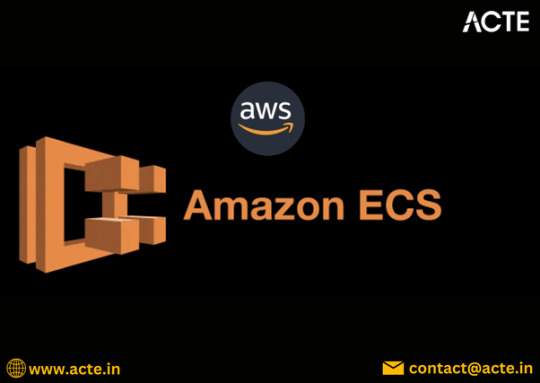
What is Amazon ECS?
Amazon ECS allows you to run Docker containers on a managed cluster of Amazon EC2 instances. It abstracts the complexity of infrastructure management, enabling you to focus on building and deploying applications. With ECS, you can easily manage the lifecycle of your containers, scale applications based on demand, and integrate with other AWS services.
Key Features of Amazon ECS
1. Task Definitions
Task definitions are a crucial component of ECS. They define the parameters for your containers, including the Docker image to use, CPU and memory requirements, networking settings, and environment variables. This makes it easy to deploy consistent and repeatable container instances.
2. Service Management
ECS allows you to define services that maintain a specified number of task instances running at all times. If a task fails, ECS automatically replaces it, ensuring high availability for your applications.
3. Integration with AWS Services
ECS seamlessly integrates with other AWS services, such as Amazon RDS, Amazon S3, and AWS Lambda. This integration helps you build complex applications that leverage the full power of the AWS ecosystem.
4. Scalability and Load Balancing
ECS supports auto-scaling, allowing you to adjust the number of running tasks based on application demand. You can set up policies that scale your services in or out automatically, ensuring optimal performance while minimizing costs.
5. Security Features
ECS provides robust security controls, including IAM roles for fine-grained access management, VPC support for network isolation, and encryption options for sensitive data. This helps you maintain compliance and protect your applications.
6. Support for Fargate
AWS Fargate is a serverless compute engine for running containers. With Fargate, you can run ECS tasks without managing the underlying EC2 instances, simplifying deployment and scaling further.
To master the intricacies of AWS and unlock its full potential, individuals can benefit from enrolling in the AWS Online Training.
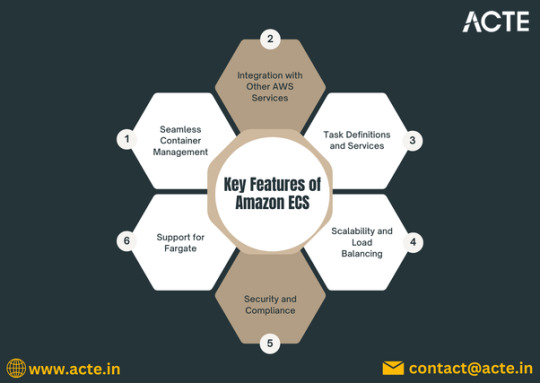
Benefits of Using Amazon ECS
Cost Efficiency: With ECS, you only pay for the resources you use, reducing infrastructure costs. Fargate eliminates the need for provisioning EC2 instances, allowing for more flexible billing.
High Availability: ECS is built for resilience. Its automatic health checks and self-healing capabilities ensure your applications remain available even in the face of failures.
Flexibility in Deployment: You can choose to run your containers on EC2 instances or use Fargate, giving you the flexibility to select the best deployment model for your needs.
Best Practices for Using Amazon ECS
Use Task Definitions Wisely: Create reusable task definitions to minimize duplication and ensure consistency across environments.
Implement Auto-Scaling: Set up auto-scaling policies based on metrics such as CPU utilization or request count to optimize resource usage.
Leverage IAM for Security: Use IAM roles to define permissions for your tasks, ensuring that your applications have access to only the resources they need.
Monitor and Log: Utilize AWS CloudWatch for monitoring and logging your ECS services. This will help you identify performance bottlenecks and troubleshoot issues.
Test Before Production: Always test your applications in a staging environment before deploying to production. This helps catch issues early and ensures a smooth rollout.
Conclusion
Amazon ECS is a robust solution for managing containerized applications in the cloud. With its rich feature set, seamless integration with AWS services, and support for both EC2 and Fargate, ECS provides the tools necessary to build, deploy, and scale applications efficiently. By understanding its capabilities and following best practices, you can harness the full potential of Amazon ECS to enhance your application development and deployment processes.
0 notes
Text
Mastering DevOps with GitLab CI/CD, Docker, and AWS Fargate
Table of Contents Project Overview Technology Stack Architecture Diagram Step 1: Prerequisites Step 2: Configuring GitLab as Version Control Step 3: Preparing AWS Resources Step 4: Building and Pushing the Docker Image Step 5: Setting Up Amazon ECS with Fargate Step 6: Creating the GitLab CI/CD Pipeline Step 7: Adding Monitoring with AWS CloudWatch Conclusion Author In today’s…
0 notes
Text
Deploying a Microservices Architecture with AWS ECS and Fargate
Introduction Deploying a Microservices Architecture with AWS ECS and Fargate is a crucial step in modernizing your application architecture. This tutorial will guide you through the process of deploying a microservices architecture using Amazon Elastic Container Service (ECS) and Amazon Fargate. By the end of this tutorial, you will have a comprehensive understanding of how to deploy a…
0 notes
Text
youtube
#youtube#video#codeonedigest#microservices#aws#microservice#docker#awscloud#aws ecs fargate tutorial#elastic container service#elasticcontainerservice#fargate#aws fargate#nodejs projects#nodejs module#nodejs express#node js#nodejs tutorial#nodejs#node js training#node js development company#node js express
0 notes
Text
App Dev - Java_only on W2
Title: App Dev – Java – Mid Location: McLean, VA Languages Java, Spring/Spring Boot, Python, GraphQL, and Gradle… Orchestration Docker, AWS (ECS Lambda, Fargate, CloudWatch) Required Skills : Must Have – Java with Spring/Spring Boot – Python… Apply Now
0 notes
Video
youtube
Deploy Your NestJS App to AWS ECS Fargate with SSL Certificate
0 notes
Text
Amazon CloudFront VPC Origins: Improved CloudFront Security
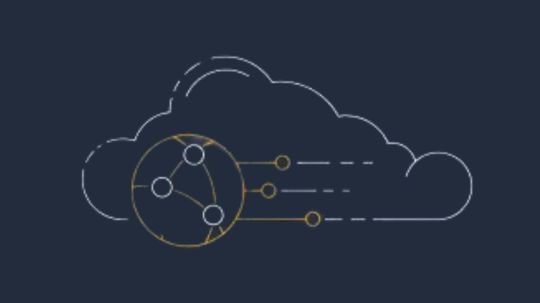
Introducing the Amazon CloudFront VPC Origin: Improved protection and more efficient use of your apps
I’m happy to inform you that the Amazon CloudFront Virtual Private Cloud (VPC) origins has launched, a new feature that allows businesses to serve content from apps housed in private subnets inside their Amazon VPC. This makes it simple to protect web apps, so you can concentrate on expanding your company while enhancing security and preserving great speed and worldwide scalability with CloudFront.
Origin Access Control is a managed service that allows customers to safeguard their origins and make CloudFront the only front-door to your application when serving content via Amazon Simple Storage service (Amazon S3), AWS Elemental Services, and AWS Lambda Function URLs. For apps that employ load balancers or are hosted on Amazon Elastic Compute Cloud (Amazon EC2), this was more challenging to accomplish because you had to come up with your own method to get the same outcome. To guarantee that the endpoint remained exclusive to CloudFront, you would need to employ a variety of strategies, including monitoring firewall rules, employing logic like header validation, and using access control lists (ACLs).
By providing a managed solution that can be used to send CloudFront distributions to Application Load Balancers (ALBs), Network Load Balancers (NLBs), or EC2 instances inside your private subnets, CloudFront VPC origins eliminates the requirement for this type of undifferentiated effort. Because it also removes the need for public IP addresses, this guarantees that CloudFront will be the only point of entry for those resources with the least amount of configuration work, giving you better performance and the chance to save money.
Setting up CloudFront VPC Origin
The fact that CloudFront VPC origins is free of charge means that any AWS client can use it. Using the AWS Command Line Interface (AWS CLI) or the Amazon CloudFront console, it may be linked with both new and pre-existing CloudFront distributions.
Consider that you have a private AWS Fargate application for Amazon ECS that is fronted by an ALB. Using the ALB directly within the private subnet, let’s build a CloudFront distribution.
To begin, open the CloudFront dashboard and choose the newly added VPC origins menu item.Image credit to AWS
It’s easy to create a new VPC origin. There aren’t many options for you to choose from. You can either input the Origin ARN directly or search for resources hosted in private subnets. You pick the resources you want, give your VPC origin a catchy name, set up some security settings, and then confirm. Although support for resources across all accounts is on the horizon, please take note that the VPC origin resource must be in the same AWS Account as the CloudFront distribution at launch.
Your VPC origin will be deployed and operational after the creation procedure is finished! On the VPC origins page, you can see its current state.
By doing this, it has developed a CloudFront distribution that, with just a few clicks, can serve content straight from a resource hosted on a private subnet! Once your VPC origin has been built, you can go to your Distribution window and copy and paste the ARN or choose it from the dropdown menu to add the VPC origin to your Distribution.
To achieve full-spectrum protection, keep in mind that you should still layer your application’s security using services like AWS Web Application Firewall (WAF) to guard against web vulnerabilities, AWS Shield for managed��DDoS protection, and others.
In conclusion
By allowing CloudFront distributions to serve content directly from resources hosted within private subnets, CloudFront VPC Origins provides a new means for enterprises to create high-performance, secure applications. This keeps your application safe while lowering the difficulty and expense of maintaining sources that are visible to the public.
Read more on govindhtech.com
#AmazonCloudFront#VPCOrigins#CloudFrontSecurity#AmazonSimpleStorageservice#AmazonS3#EC2instances#AmazonElasticComputeCloud#AmazonEC2#DDoSprotection#technology#technews#news#govindhtech
0 notes
Text
Kumologica Container Inside AWS ECS Fargate
http://securitytc.com/TFq3Gj
0 notes
Photo

(Web アプリケーションにおける Amazon ECS / AWS Fargate アーキテクチャデザインパターン - builders.flash☆ - 変化を求めるデベロッパーを応援するウェブマガジン | AWSから)
0 notes